
Can you guess how many blog posts I have on NeilPatel.com?
Well, if you guessed 4,784 you’re wrong. 😉
Technically I just published this blog post, which makes it 4,785.
That’s a lot of content! Especially considering that the blog has been around for roughly 4 years. That means that I am publishing an average of 3.27 blog posts per day.
I know what you are thinking… seems a bit too much content for one person to write.
Well, let’s first go over how I published 4,784 blog posts in 4 years.
Did you really write all 4,784 posts?
Just look at the screenshot below:
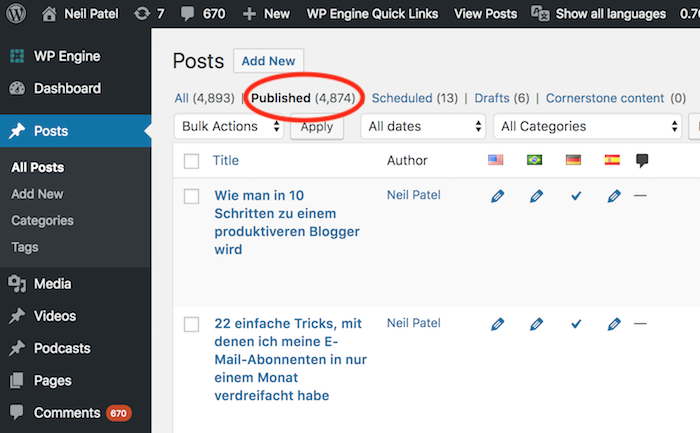
As you can see there really are 4,784 blog posts published on NeilPatel.com.
But here’s the thing: If you look closely at the image you’ll notice that some of the posts are in different languages.
There’s content in German, Spanish, Portuguese, and English. And no, I don’t know how to fluently speak all of those languages.
Which means I only wrote the English posts.
In other words, I paid people to manually translate my content into multiple languages.
In addition to that, I acquired the KISSmetrics blog and their 1,313 blog posts got merged into NeilPatel.com.
So, I only wrote 862 blog posts myself. The rest are from the KISSmetrics blog and translations (not all of the content has been translated).
Considering that I didn’t have to write all of the 4,784 blog posts, you are probably wondering why I regret it.
Why wouldn’t you write all that content?
More content doesn’t mean more traffic. It’s really that simple.
Sure, if you blog 100 times a day like those news sites your traffic should go up. But there is no guarantee because there are 199 other factors that Google is looking at.
Plus, it would be really expensive to produce 100 pieces a day!
Let’s look at the traffic on NeilPatel.com:
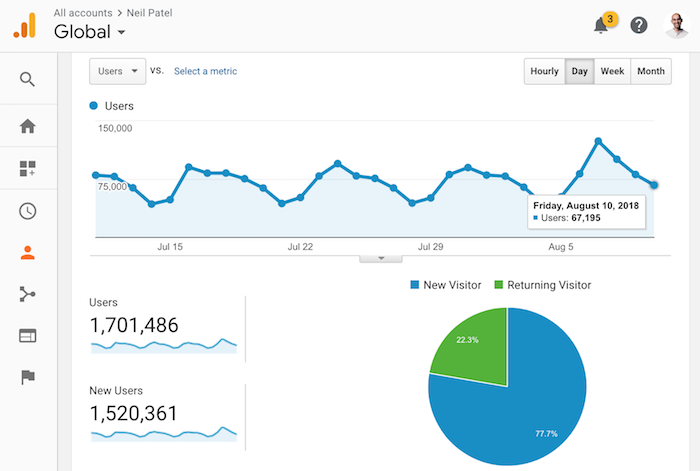
As you can see from the image above, my blog generated 1,701,486 unique visitors and 5,948,818 page views. Now let’s look at what pages are generating the visitors.
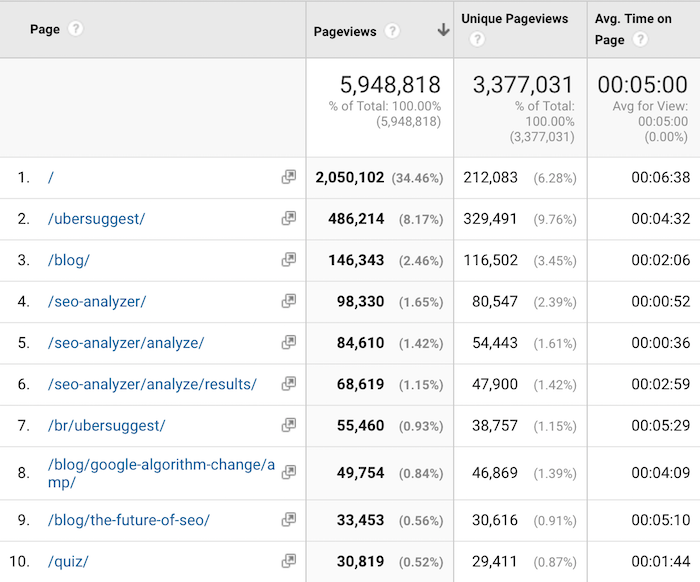
You’ll notice that my homepage generates a lot of page views. A large portion of that is bot traffic that is coming from Turkey. Don’t ask me why!
So, let’s look at the “unique page views” number as that number excludes most of the bot traffic.
The top 10 pages account for 29.23% of the traffic. But what’s crazy is that 5 of the 10 most popular pages are tools. (That’s why I switched my SEO strategy to spend more time and money on technology.)
But I love blogging, so I wouldn’t just stop writing.
Now, let’s look at the top 50 pages:
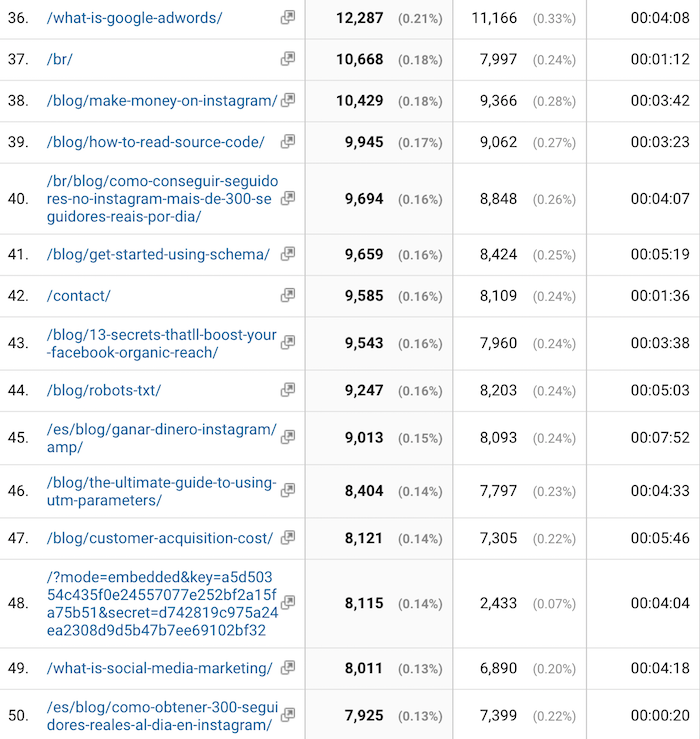
The top 50 pages make up 45.75% of my traffic. As you can see, each post starts driving a lot less traffic when you go past the top 10 pages.
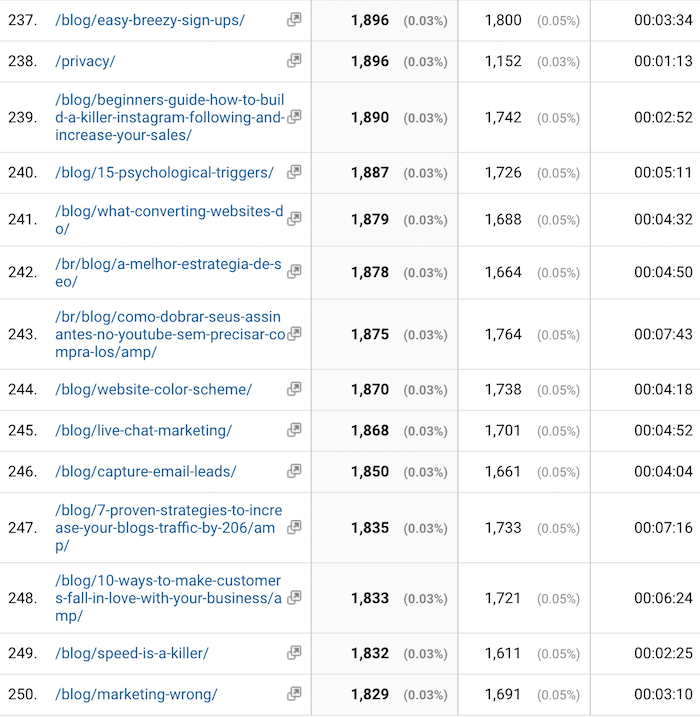
And the numbers get smaller as you keep going down the list. The top 250 pages make up 64.49% of my traffic. The top 500 pages make up 72.96% of the traffic. And the top 1000 pages make up 80.99% of the traffic.
In other words, most of the content doesn’t even generate that much traffic. More than half of my content doesn’t even generate 83 visits a month.
Read that again:
More than half of my content doesn’t even generate 83 visits a month!!
There are a few popular posts and pages that do extremely well and then there is a huge long tail, in which the rest of the content barely generates any traffic.
And I am the unique case because I know SEO, social media marketing, and content marketing better than most people. I am able to generate more traffic to my unpopular posts than most blogs.
To prove it, I analyzed data from 11 blogs that generate anywhere from 1,301,492 to 24,502,503 unique visitors a month. And these blogs have anywhere from 5,592 to 29,095 blog posts.
Let’s look at what portion of their traffic comes from their top 10, 50, 250, 500, and top 1,000 pages.
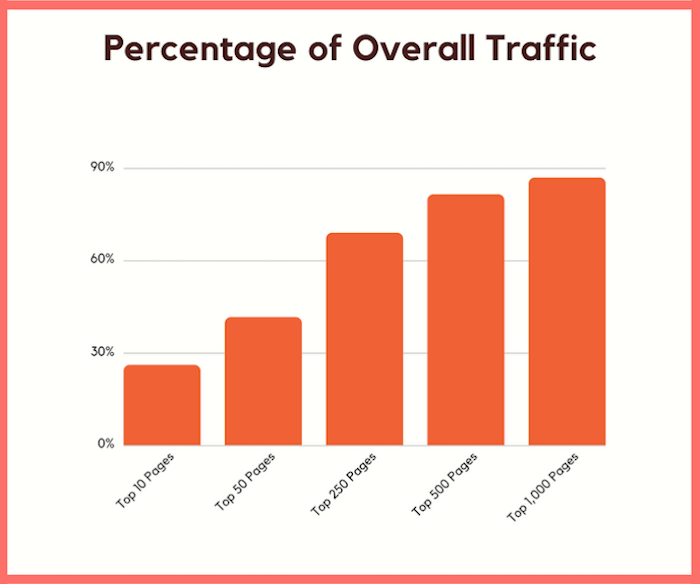
You’ll notice that their top 10 and even top 50 pages don’t make up as high of a percentage of their total traffic compared to NeilPatel.com, but you have to keep in mind that none of these blogs have tools. People love tools.
But their top 250 pages make up 68.97% of their total traffic, their top 500 pages make up 81.45%, and their top 1,000 pages make up 86.88%.
Assuming your blog is large, you’ll find that it is hard to generate traffic outside the top 10% of your content. If you know SEO well, you can make those numbers a bit better like I have, but it isn’t easy.
So why would you want to write tons of content people won’t read?
So, what would you do instead?
As I mentioned above, I love blogging. So, no matter what, I wouldn’t stop. It’s not only about the traffic, it’s not only about the revenue, blogging is just fun for me.
But I would have adjusted my strategy earlier on.
I would use tools like Ubersuggest and Ahrefs to see the top pages of my competitors (the screenshot below is from the new Ubersuggest tool, which is not out yet).
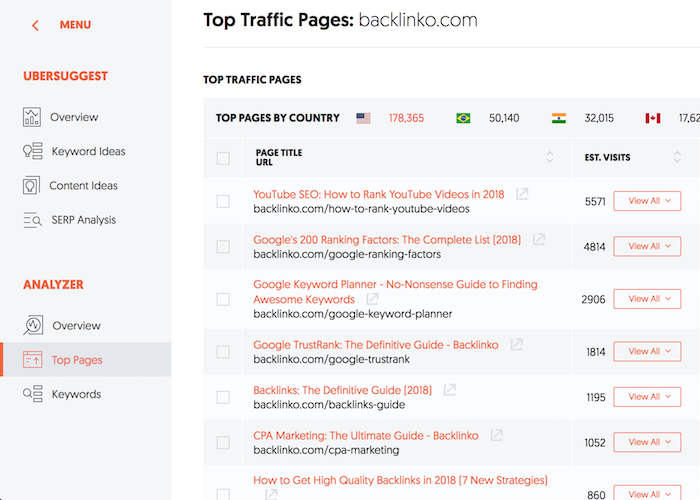
Then I would dig in and see what keywords are driving their traffic.
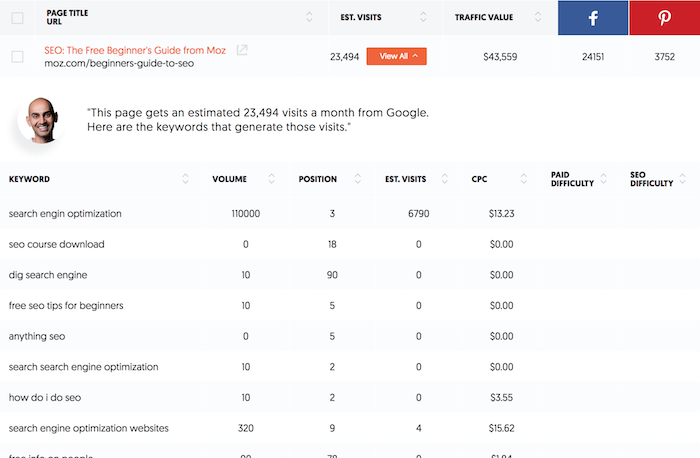
From there I would double check to make sure that that the page also is loved by people and not just search engines. I would do this by looking at the social share count, which you can also see in the screenshot above.
In other words, if people are sharing content heavily on social sites like Facebook, it means that they enjoyed reading the content.
Once you have a list of blog posts that do really well for your competition, from both a human and search engine perspective, you’ll want to create better versions of it.
That means you will want to make your content more in-depth, with better screenshots, maybe even include video tutorials, infographics, or whatever else you can think of that will make your post better than the competitions.
This way you are ONLY writing content that has a good chance of getting tons of traffic versus cranking out hundreds if not thousands of content pieces that very few people will ever read.
So, would you still translate your content?
Similar to how I would still blog, but just not write 4,784 posts, I would translate my content, but just not all of it.
When I started translating my content, I made a huge mistake.
Can you guess what it is?
It’s that I was translating my content.
Here’s what I mean…
Even if you hire smart people who know your industry to translate your content, it doesn’t guarantee success. What’s popular in one country isn’t always popular in another country.
For that reason, you have to use keyword research tools like Ubersuggest to see what keywords are popular in each country.

My traffic in regions like Brazil didn’t start growing fast until we started to transcribe the content and adapt it to the region. And now I can generate over 209,949 unique visitors a month from Brazil.
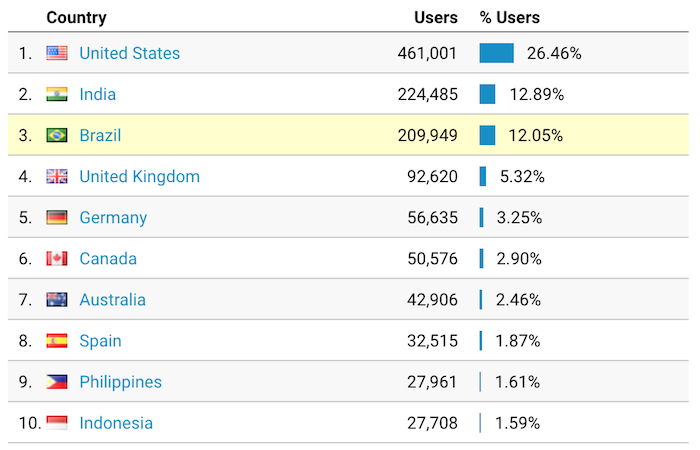
Even if you focus on only writing content people love and if you ever decide to expand internationally there is one big issue that you are going to face.
More content means more maintenance
People don’t really talk about this, but if you write thousands of blog posts as I have your traffic will eventually go down if you don’t update and maintain your old content.
It’s different for news website because their content isn’t evergreen.
But assuming you are writing evergreen content like me your traffic will drop if you don’t continually update your old, outdated content.
With NeilPatel.com my traffic has continually grown over time because I constantly update my old content, but I didn’t do that with my previous blog, Quick Sprout.
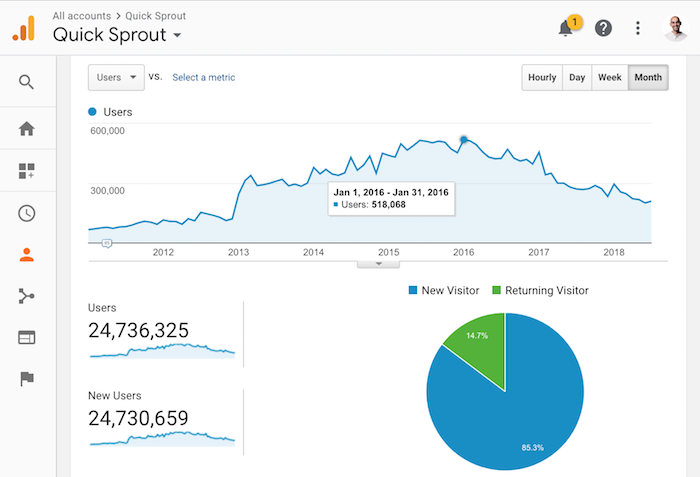
Quick Sprout peaked at around 518,068 unique visitors a month. New content is still published on the blog each week, the on-page SEO is fine and the number of sites that link to Quick Sprout has grown over time.
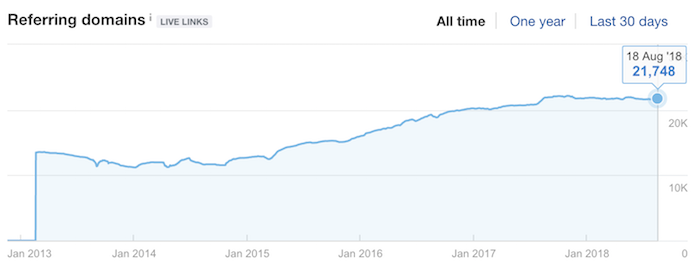
Yet the traffic is continually dropping because I haven’t been updating the old content.
When you have a lot of content like I do, it is a huge pain to update thousands of blog posts each year.
Luckily for me, I have an amazing team that goes through each post at least once a year and figures out if it needs to be updated (and if it does, they update it).
Conclusion
If I were starting over, I would use the simple process I described above, in which I would only write new content based on what both people and search engines love.
I would figure out what that content is by using tools like Ahrefs and Ubersuggest. I would look at total search traffic each blog post gets as well as how many social shares it has.
And as for how many posts you should publish, it really depends on your competition.
For example, if no one in your industry is doing content marketing, I would start off with one post a week until you figure out what works and what doesn’t. Because you wouldn’t be able to use tools Ahrefs or Buzzsumo to see what’s hot in your industry due to no one doing content marketing.
On the flip side, if you are in a space where all of your competitors are doing content marketing, I would try to play a game of catchup and crank out a blog post a day based on what’s popular.
But I wouldn’t write more than one post a day because content marketing isn’t just about writing content, it’s also about promoting the content.
And it is really hard to promote more than one piece a day. That’s why I blog weekly now instead of daily.
If you are wondering what process I use to promote and market my content, I break it down here. Here is a quick overview of my process:
- Boosting posts – I spend $400 to boost each of my posts on Facebook. I don’t know why I spend $400 instead of $100 or even $1,000… it’s just a random number that I am comfortable spending each week.
- Email everyone I link to – the second step I take is to email everyone I link out to. I ask them to share my content on the social web. (I provide an email template that you can use in the original post that breaks down my process)
- Top sharers – I look to see who shared competitor articles on the social web and I ask them to share mine. (I also provide instructions and a template for this in the original post)
- Beg for links – see who links to your competition and ask them to link to your site. This will help boost your search engine rankings. (I also provide instructions and a template for this in the original post)
And if you are wondering how much time you should spend writing versus marketing, use the 80/20 rule.
20% of your time should be spent on writing content and 80% of the time should be used to promote your content.
Keep in mind the goal isn’t to write more blog posts than everyone else in your space, it’s to only write posts that generate high volumes of traffic.
Of course, when you are following this advice, you’ll still find yourself writing content that doesn’t do too well every once in a while. That’s ok and every blog has that issue… but overall you won’t be stuck with thousands of blog posts that generate little to no traffic.
If you look at the NeilPatel.com blog, you’ll also notice that I only blog once a week. It’s because I’ve found it more effective. Once I switched to the strategy of blogging less, my traffic started to climb faster.
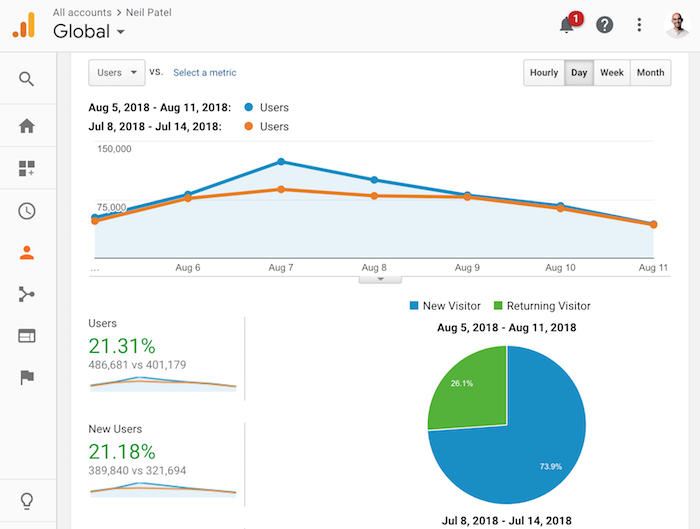
Sure, it’s less content for Google to index, but I’m spending more time promoting the content, hence my traffic is 21.31% higher.
So how many blog posts have you written? Are you going to change your strategy of blogging less frequently?
The post Less is More: Why I Wish I Never Wrote 4,784 Blog Posts appeared first on Neil Patel.
from Blog – Neil Patel https://ift.tt/2w0wPnt
via IFTTT
